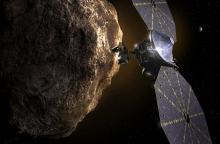Listen to today's episode of StarDate on the web the same day it airs in high-quality streaming audio without any extra ads or announcements. Choose a $8 one-month pass, or listen every day for a year for just $30.
You are here
Planning Ahead
Astronomy is planning ahead. Committees of the National Academy of Sciences are taking a look at big-ticket projects for the next decade and beyond. Their recommendations to NASA will help outline the agency’s priorities for a long time to come.
The work is mandated by Congress. Reviewers look at key scientific questions that need to be addressed, and how NASA can tackle those questions. Different panels look at different subject areas.
One, for example, is evaluating proposals for exploring the solar system. The last survey in that area was completed in 2011. Among its top priorities were a mission to Jupiter’s moon Europa, plus another to bring back samples from Mars. Both of those projects received a go-ahead from NASA.
This time around, the proposals include one that would study Enceladus, one of the moons of Saturn. An ocean below its crust appears to have all the ingredients needed for life.
Another proposed mission would put a craft in orbit around Titan, Saturn’s biggest moon. The craft would drop small probes to the surface, which is blanketed by a dense atmosphere made of hydrocarbons. And yet another mission would send an orbiter and probe to study Neptune and its biggest moon, Triton.
These and other missions would cost billions of dollars each. So evaluators will take a close look at each one before making their recommendations next year — helping astronomy plan for the next decade and beyond.






